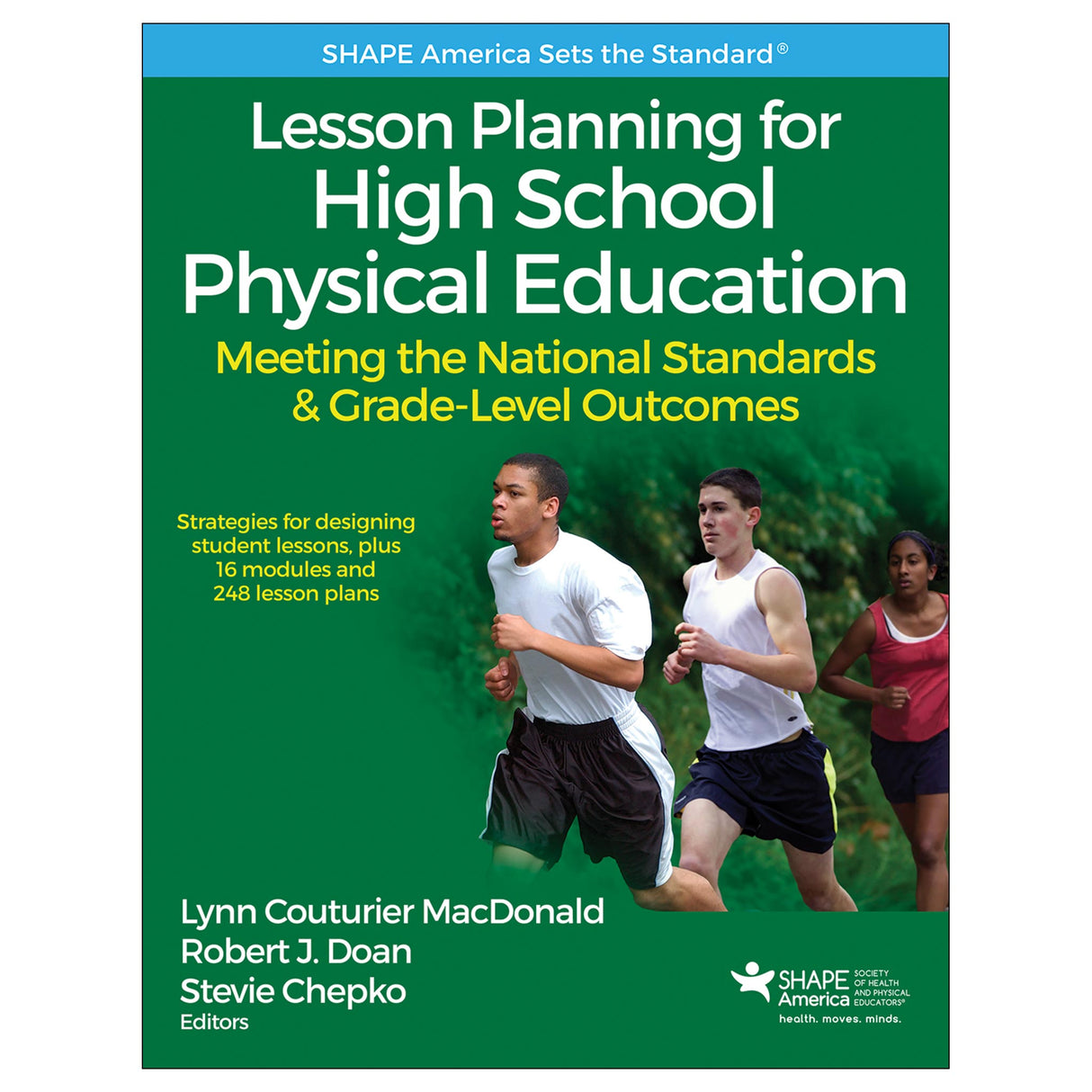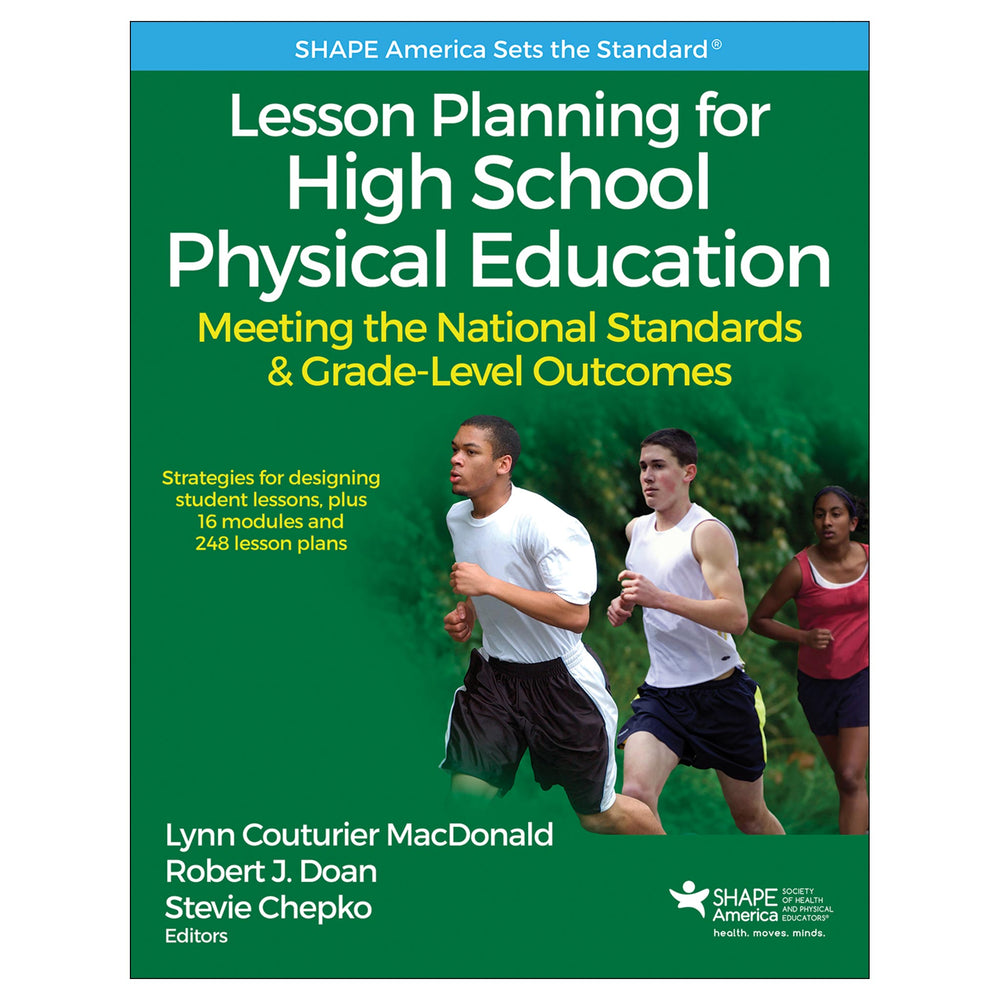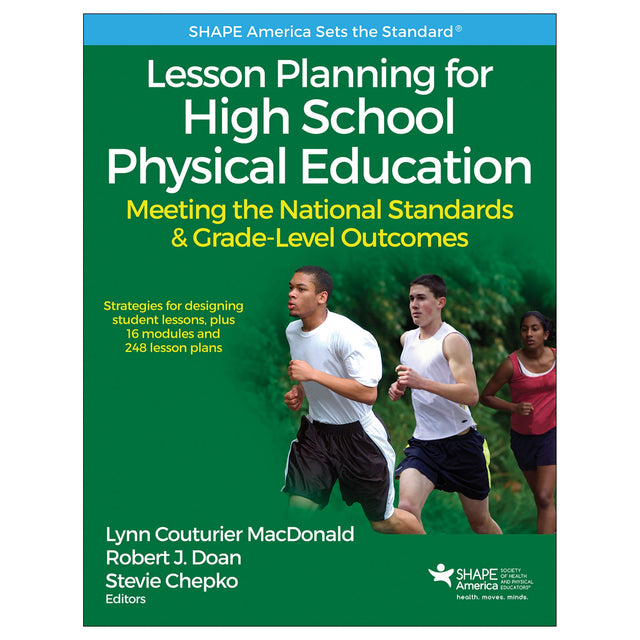Lesson Planning for High School PE With Web Resource
Meeting the National Standards & Grade-Level Outcomes
$97.95 CAD
Lesson Planning for High School Physical Education provides standards-based, ready-to-use lesson plans that enhance student learning and help students become physically literate. Designed to complement the successful elementary and middle school books in the series, this book also provides guidance on how to plan effective lessons that align with SHAPE America’s National Standards and Grade-Level Outcomes for K-12 Physical Education.
Lesson Planning for High School Physical Education is written by master teachers and edited by SHAPE America. In this book, you’ll find:
• More than 240 lesson plans that provide deliberate, progressive practice tasks and integrate appropriate assessments to evaluate and monitor student progress
• Innovative and unique modules on topics such as fly fishing, rock climbing, line dance, yoga and stress management, and more, as well as more traditional modules
• Introductory chapters that present the key points for the grade span, putting the lessons in context and providing teachers and PE majors and minors a clear roadmap for planning curricula, units, and lessons
• Lessons that reflect best practices in instruction, helping teachers enhance their effectiveness
• Expert guidance in delivering quality lessons that are designed to reach objectives and produce outcomes, and not just keep students occupied
The lessons correspond to each category in SHAPE America’s National Standards and Grade-Level Outcomes for K-12 Physical Education, and are sequential and comprehensive—you get complete, ready-to-use units and not just individual lessons that don’t connect. The lessons include resource lists, references, equipment lists, and student assignments. The accompanying web resource offers easy access to printable PDF files of the lessons. Your administrator will be able to see at a glance that the lessons in the book are designed to meet the national standards and outcomes created by SHAPE America.
The lessons in Lesson Planning for High School Physical Education can be used as they are or modified to fit the needs of your students. They also are perfect models for teachers and college students to use in creating their own lessons. The text includes instructional strategies such as how to teach for transfer, utilize grids and small games, differentiate instruction for varying ability levels, integrate conceptual material, and more.
The book is organized into two parts. Part I explores issues pertinent to planning for high schoolers’ success, including how to plan lessons using SHAPE America’s Grade-Level Outcomes, meeting the National Standards and Grade-Level Outcomes, developing an electives-based program for high school students, and the importance of teaching for student learning.
The lesson plans themselves are found in Part II, and each lesson aligns with SHAPE America’s National Standards and Grade-Level Outcomes for K-12 Physical Education. Part II offers plans in these categories:
• Outdoor pursuits
• Individual-performance activities
• Net and wall games, such as badminton and tennis
• Target games
• Dance and rhythms
• Fitness activities, such as Pilates, resistance training, and yoga
• Personal fitness assessment and planning
Each category contains modules of 15 or 16 lessons, each of which incorporates various National Standards and Grade-Level Outcomes. For example, you can address Standard 4 outcomes—which are about personal and social responsibility—during lessons on net and wall games, lessons on dance and rhythms, and so on.
With the high-quality lesson content and the many tools and resources provided, Lesson Planning for High School Physical Education will help teachers foster their students’ physical literacy and help students develop physically active lifestyles that they can maintain throughout their adult lives.
Human Kinetics is proud to publish this book in association with SHAPE America, the national organization that defines excellence for school-based health and physical education professionals across the United States.
Audience
Text for undergraduate physical education methods and pedagogy courses. Reference for high school physical education and classroom teachers.
Part I Planning for Student Success in High School
Chapter 1. The Importance of Teaching for Student Learning in High School
Lynn Couturier MacDonald, Robert J. Doan, and Stevie Chepko
Factors That Influence Student Learning
The Instructional Environment
How the Grade-Level Outcomes Are Coded
Understanding the Scope and Sequence for K-12 Physical Education
Chapter 2. Teaching to Standards: Planning Lessons Using the Grade-Level Outcomes
Lynn Couturier MacDonald, Stevie Chepko, and Robert J. Doan
Planning for the Module
Planning for Individual Lessons
Setting Up the Lesson
Planning for Embedded Outcomes
Optimizing Learning Through Embedded Outcomes
Summary
Chapter 3. Meeting the National Standards and Grade-Level Outcomes in High School
Lynn Couturier MacDonald, Robert J. Doan, and Stevie Chepko
High School Is Different
The Progression From Middle School
High School Instructional Environment
Grade-Level Outcomes for High School Students (Grades 9-12)
Operational Definitions of Activity Categories
Chapter 4. Developing an Electives-Based Program for High School Students
Aaron Hart
Why Consider Electives-Based Physical Education?
Select a Design, Create a Plan, and Then Implement the Program
Personalized Curriculum Design
Take the First Step
Part II Lesson Plans for High School Physical Education
Chapter 5. Extending Students’ Skills and Knowledge to Outdoor Pursuits
Tracy Krause
Integrated Fly Fishing
Hiking
Rock Climbing
Chapter 6. Extending Students’ Skills and Knowledge to Individual-Performance Activities
Adrienne Koesterer and Mary Westkott
Aquatics
Multi-Sport Events
Chapter 7. Extending Students’ Skills and Knowledge to Net and Wall Games
Charla Tedder Krahnke, Melanie Perrault, and Charlie Rizzuto
Badminton
Tennis
Tennis Doubles
Chapter 8. Extending Students’ Skills and Knowledge to Target Games
Brandon Allen
Beginning Golf
Chapter 9. Extending Students’ Skills and Knowledge to Dance and Rhythms
Patrice Lovdahl and Lisa Jacob
Line Dance
Choreography
Chapter 10. Extending Students’ Skills and Knowledge to Fitness Activities
Ericka Fangiullo, Anthony Smith, and Joni M. Boyd
Yoga and Stress Management
Resistance Training
Pilates
Chapter 11. Extending Students’ Skills and Knowledge to Designing and Implementing Personal Fitness Plans
Rebecca Bryan
Fitness Assessment and Program Planning
Fitness Walking
Upper-Body Machines
Why Consider Electives-Based Physical Education?
The web resource includes lesson plans in PDF format for easy printing or for accessing on a tablet or computer.
All ancillary materials for this text are FREE to course adopters and available online at www.HumanKinetics.com/LessonPlanningForHighSchoolPhysicalEducation.
Human Kinetics is pleased to partner with SHAPE America by offering discounts on our resources to SHAPE America members! Whether you’re a preK-12 teacher, higher education faculty member, researcher, administrator, or future professional, we’re here to help you in your professional career and personal fitness journey of improved fitness, stronger athletic performance, and better nutrition.
SHAPE America members receive a 30% discount on this resource and other eligible resources through the member portal at SHAPE America. Learn more about SHAPE America membership at SHAPEAmerica.org or direct your questions about the discount to askmembership@shapeamerica.org.





